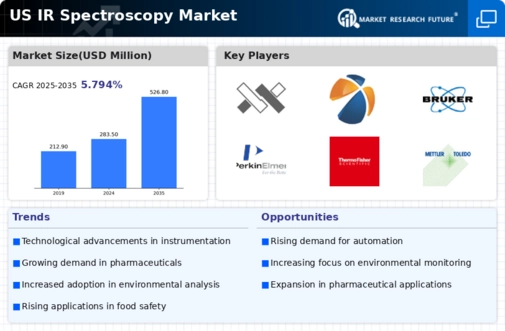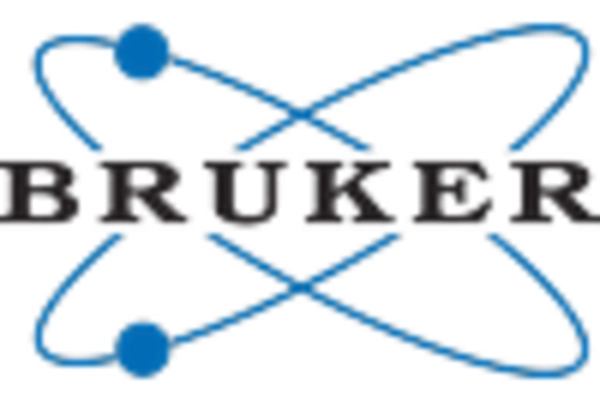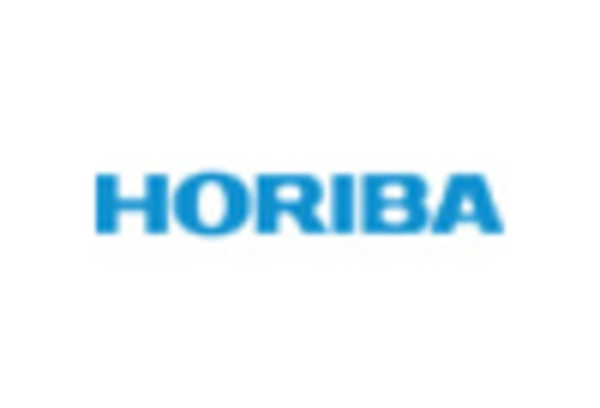Rising Demand in Pharmaceutical Sector
The pharmaceutical sector is experiencing a notable increase in the adoption of advanced analytical techniques, including those utilized in the The pharmaceutical sector is experiencing a notable increase in the adoption of advanced analytical techniques, including those utilized in IR spectroscopy.. This demand is driven by the need for precise quality control and assurance in drug development processes. As regulatory bodies emphasize stringent testing protocols, the ir spectroscopy market is positioned to benefit significantly. In 2025, the pharmaceutical industry in the US is projected to allocate approximately $5 billion towards analytical instrumentation, with a substantial portion directed towards ir spectroscopy technologies. This trend indicates a robust growth trajectory for the ir spectroscopy market, as pharmaceutical companies seek to enhance their research and development capabilities.
Emerging Applications in Material Science
The field of material science is witnessing a surge in the application of ir spectroscopy techniques, which is likely to drive growth in the The field of material science is witnessing a surge in the application of IR spectroscopy techniques.. Researchers are increasingly utilizing this technology to analyze the properties and compositions of new materials, including polymers and nanomaterials. In 2025, the material science research funding in the US is projected to reach $1.5 billion, with ir spectroscopy being a key analytical tool. This trend indicates that as new materials are developed, the demand for ir spectroscopy will likely increase, further solidifying its role in advancing material science research.
Growth in Food and Beverage Safety Testing
The food and beverage industry is increasingly prioritizing safety and quality assurance, which is positively impacting the The food and beverage industry is increasingly prioritizing safety and quality assurance, which is positively impacting IR spectroscopy.. With rising consumer awareness regarding food safety, manufacturers are investing in advanced testing methods to ensure compliance with safety standards. In 2025, the food safety testing market in the US is projected to exceed $4 billion, with ir spectroscopy playing a pivotal role in detecting contaminants and verifying product authenticity. This trend suggests that the ir spectroscopy market will continue to expand as food and beverage companies seek reliable and efficient testing solutions.
Increased Focus on Environmental Monitoring
Environmental monitoring has become a critical area of concern, leading to heightened interest in the Environmental monitoring has become a critical area of concern, leading to heightened interest in IR spectroscopy.. The need for accurate detection of pollutants and hazardous substances in air, water, and soil is driving investments in analytical technologies. In 2025, the US environmental testing market is expected to reach $3 billion, with a significant share attributed to ir spectroscopy applications. This technology offers rapid and reliable analysis, making it indispensable for regulatory compliance and environmental protection efforts. As environmental regulations become more stringent, the ir spectroscopy market is likely to see increased demand from both public and private sectors.
Technological Integration in Research Laboratories
Research laboratories across various sectors are integrating advanced technologies to enhance their analytical capabilities, thereby influencing the Research laboratories across various sectors are integrating advanced technologies to enhance their analytical capabilities, thereby influencing IR spectroscopy.. The trend towards automation and digitalization in laboratory settings is fostering the adoption of sophisticated ir spectroscopy instruments. In 2025, it is estimated that the market for laboratory automation in the US will reach $2 billion, with a considerable portion dedicated to ir spectroscopy systems. This integration not only improves efficiency but also enhances data accuracy, suggesting a promising outlook for the ir spectroscopy market as laboratories strive for innovation.
















Leave a Comment